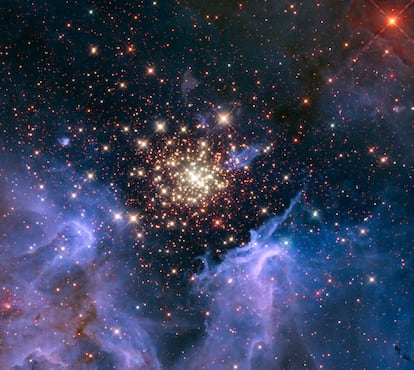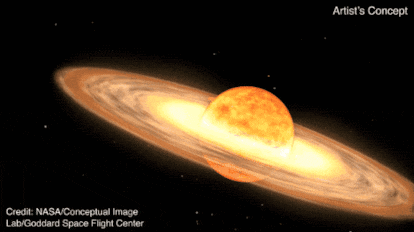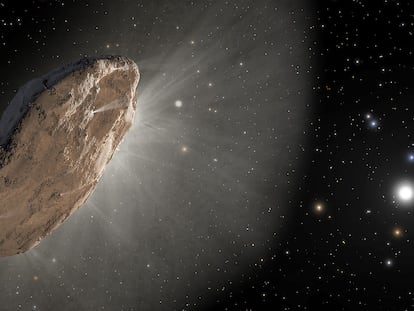T Coronae Borealis is going to explode and will be visible to the naked eye very soon
Historic observations indicate that it explodes every 80 years and that its current cycle is about to come to a close. When that happens, it will appear as a new star in the night sky

Just like people, stars are born, grow up and die. And they do so by causing massive explosions. A supernova is the death of a supergiant star, while a nova leaves its stars alive after a sudden explosive flash. In general, these events can be difficult to predict, but there are 10 known systems of white dwarfs that produce novas periodically, five of them located in our galaxy. Such is the case of T Coronae Borealis (T CrB), located 3,000 light years from Earth. Historic observations indicate that it explodes every 80 years and that its current cycle is about to come to a close. When that happens, it will appear as a new star in the night sky.
According to NASA, it’s quite probable that the star system of the two T CrB stars will once again cause a huge explosion. The last time that happened was in 1946, and some astronomers think it will take place once again between February and September of this year. (Other experts prefer not to risk such an exact estimate.) Sumner Starrfield, a University of Arizona astronomer who has observed the nova’s behavior, says regarding the date of the much-awaited event, “It could be tonight, this fall, or it could take place in 2025 or 2026.”
“There’s no real way of telling when it will explode. Our estimates that it will take place soon are based on observations of its behavior just before its explosion 80 years ago,” says Starrfield. Javier Armentia, astrophysicist and director of the Pamplona Planetarium, agrees that it is best not to rush into forecasting: “Current behavior gives us clues, but it’s not possible to define.”

Every time a new star appears in the sky, it is called a nova — which means “new” in Latin — but in reality, it is an astronomical event that causes an explosive flare from a star that was already there. T CrB is actually made up of two stars: a red giant and a white dwarf. The latter is a dense stellar core whose gravity attracts the red giant’s gas. This gas accumulates on the surface of the dwarf until it explodes in an “extremely violent” event, Armentia says. The star temporarily shines brighter, and reaches the luminous magnitude of Polaris, the North Star. Finally, it returns to normal and the cycle repeats.
Witnessing the nova will be a once-in-a-lifetime opportunity. The disparity in size between the two stars is so large that it takes the white dwarf 227 days to orbit the red giant, says Starrfield. They are so close that the material ejected by the red giant accumulates near the surface of the white dwarf. Once this mass, which is about the size of Earth, has sufficiently accumulated on the white dwarf — a process that takes about 80 years — it gets hot enough to start an uncontrolled thermonuclear reaction. This causes a huge explosion, and “in a few seconds, the temperature rises from 212 to 392 million degrees Farenheit,” says the astronomer.
A stellar explosion can show up notably in space. Depending on its magnitude and distance, events like the T CrB nova can be observed by the naked eye. If conditions are similar to what happened during its last explosion, it will be visible for about a week and then the system will quiet down in a couple of months: “We will be observing it throughout its evolution,” Starrfield says.
Novas are a rare phenomenon, and both the astronomers contacted for this article think that the T CrB nova will provide a great opportunity to learn more about them. “We don’t know much about novas. Now we have more advanced data and technology than we did in 1946,” says Armentia. And according to Starrfield, the great event will make it possible to learn how much energy is involved in such explosions, how much material is expelled by them into space, the chemical makeup of their gases, and how the massive explosions occur.
“Does it expel gas in an enormous cloud? Or with many more smaller clouds?” are the questions to which Starrfield will be looking for an answer. She is optimistic that there will be many more findings “that will surprise us.” Thanks to observation of novas, she says, proof has been found that point to our solar system having been produced in nova explosions. “We are very sure that lithium in the solar system comes from nova explosions that happened prior to the formation of the solar system,” she says. Normal novas explode “perhaps every 100,000 years,” she explains. But recurring novas repeat their explosions on a more human-friendly schedule thanks to a specific relationship between their two stars.

It is at least the third time that human beings have been witness to the T CrB nova, which was officially discovered by Ireland’s John Birmingham in 1866, and reappeared in 1946. While we wait for its next great explosion, astronomers suggest familiarizing oneself with the Corona Borealis constellation, also known as the northern crown, a small semicircular arc between the Arcturus star — one of the brightest and easiest to locate — and the Hercules constellation. “That is where the explosion will appear, as a shiny new star,” say NASA specialists.
Starrfield’s team has reserved time on the James Webb Space Telescope to observe the eruption, but theirs will be just some of many eyes that will turn toward the outburst once it begins. And no such advanced technology will be necessary to witness the extraordinary event once it occurs. The star will be visible to the naked eye for about a week, and with binoculars for a month. All you’ll need to do is go out and look at the Corona Borealis constellation.
Sign up for our weekly newsletter to get more English-language news coverage from EL PAÍS USA Edition
Tu suscripción se está usando en otro dispositivo
¿Quieres añadir otro usuario a tu suscripción?
Si continúas leyendo en este dispositivo, no se podrá leer en el otro.
FlechaTu suscripción se está usando en otro dispositivo y solo puedes acceder a EL PAÍS desde un dispositivo a la vez.
Si quieres compartir tu cuenta, cambia tu suscripción a la modalidad Premium, así podrás añadir otro usuario. Cada uno accederá con su propia cuenta de email, lo que os permitirá personalizar vuestra experiencia en EL PAÍS.
¿Tienes una suscripción de empresa? Accede aquí para contratar más cuentas.
En el caso de no saber quién está usando tu cuenta, te recomendamos cambiar tu contraseña aquí.
Si decides continuar compartiendo tu cuenta, este mensaje se mostrará en tu dispositivo y en el de la otra persona que está usando tu cuenta de forma indefinida, afectando a tu experiencia de lectura. Puedes consultar aquí los términos y condiciones de la suscripción digital.
More information

From dark constellations to solar observatories: How pre-Hispanic America contemplated the cosmos

Interstellar interlopers like Oumuamua and Borisov are much more common than previously thought
Archived In
Últimas noticias
Welcome to the post-religion era: The idea of Christianity as the absolute truth has become obsolete
‘I thought you would like it’: The risky sexual practice popularized by TV shows and TikTok
The digitalization of tourism: ‘They promise experiences and gave us the worst possible one’
Mexican peso defies uncertainty with forecasts of a new period of stability in 2026
Most viewed
- Sinaloa Cartel war is taking its toll on Los Chapitos
- Reinhard Genzel, Nobel laureate in physics: ‘One-minute videos will never give you the truth’
- Oona Chaplin: ‘I told James Cameron that I was living in a treehouse and starting a permaculture project with a friend’
- Why the price of coffee has skyrocketed: from Brazilian plantations to specialty coffee houses
- Silver prices are going crazy: This is what’s fueling the rally









































